A Critical Review on Television Binge Watching: Health Impacts
VerifiedAdded on 2023/04/08
|9
|1328
|307
Report
AI Summary
This report provides a critical review of the article "Just one more Episode", focusing on the contemporary phenomenon of television binge-watching. It examines the frequency of this behavior and its correlation with various factors, including dual processing, anticipated regret, goal conflict, and automaticity, as discussed through the lens of the Social Cognitive Theory. The review analyzes the methodology, strengths, and limitations of the original study, including the regression analysis and survey methods used to assess binge-watching habits and their psychological impacts. It also addresses the bias and the sample size limitations of the study. The conclusion highlights the need for a balanced approach to TV consumption to maintain health and well-being. The report emphasizes the growing trend of binge-watching and its implications for future research, suggesting a targeted balance based on studies of the frequency of the TV binge-watching to stay healthy.
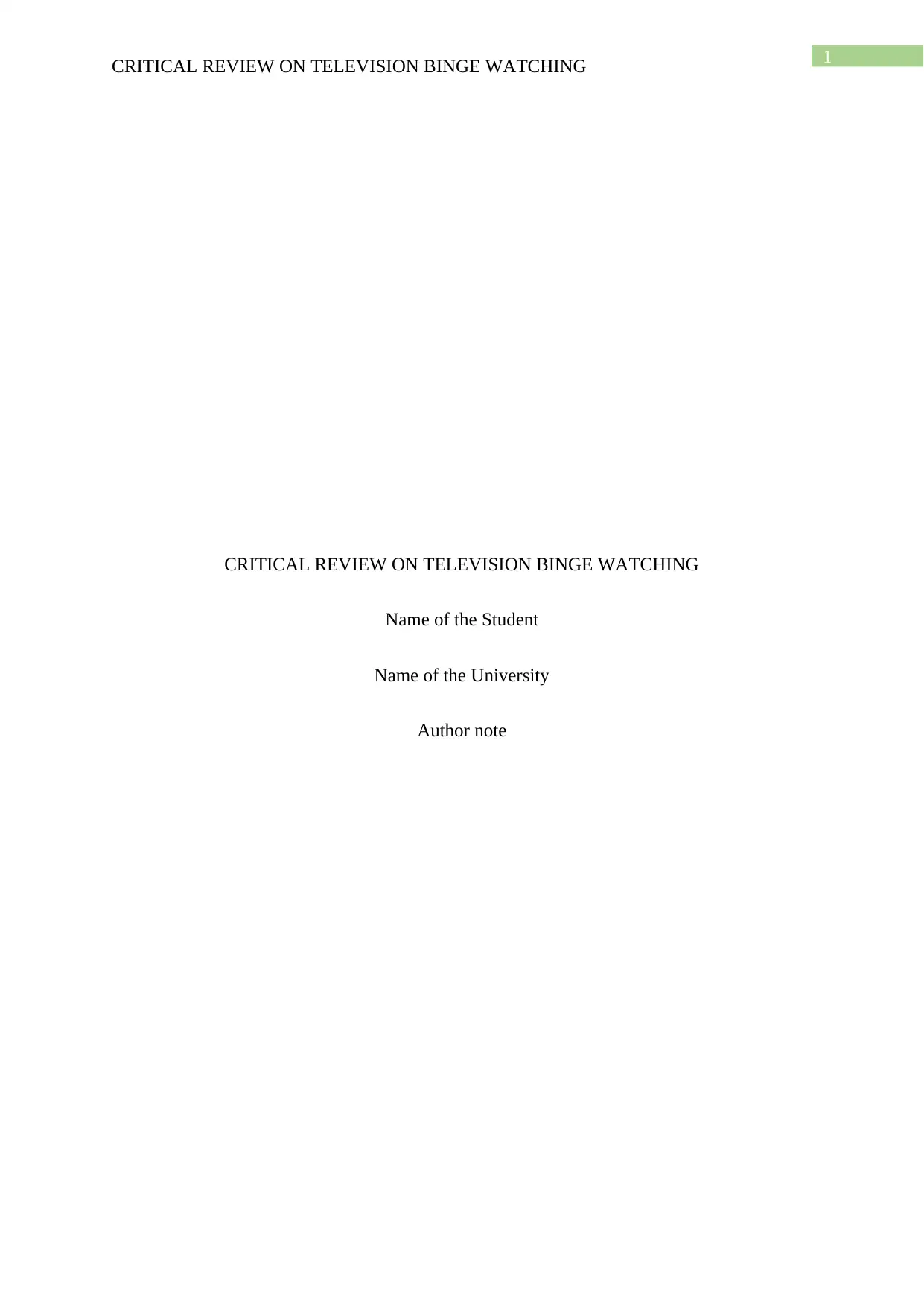
1
CRITICAL REVIEW ON TELEVISION BINGE WATCHING
CRITICAL REVIEW ON TELEVISION BINGE WATCHING
Name of the Student
Name of the University
Author note
CRITICAL REVIEW ON TELEVISION BINGE WATCHING
CRITICAL REVIEW ON TELEVISION BINGE WATCHING
Name of the Student
Name of the University
Author note
Paraphrase This Document
Need a fresh take? Get an instant paraphrase of this document with our AI Paraphraser
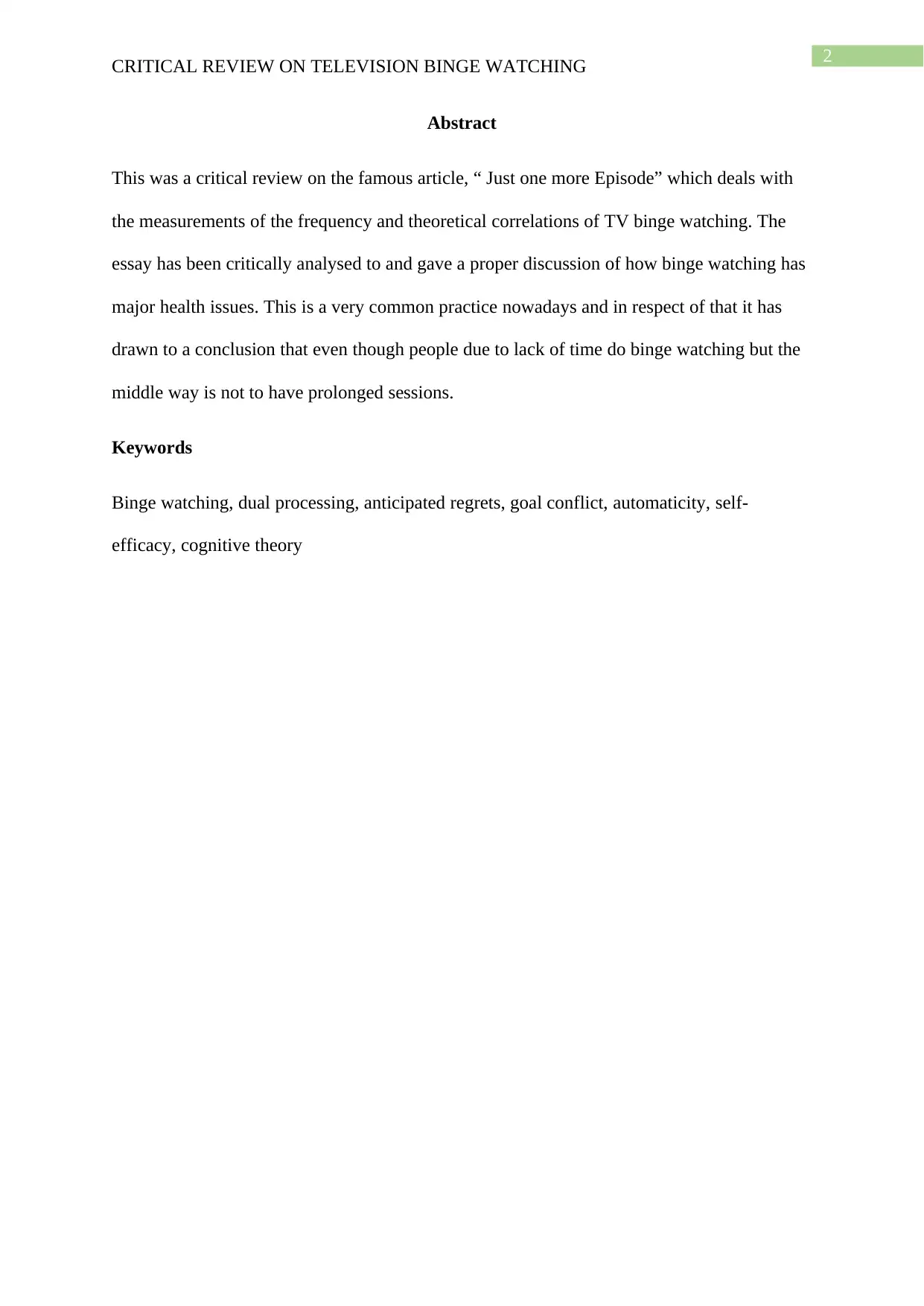
2
CRITICAL REVIEW ON TELEVISION BINGE WATCHING
Abstract
This was a critical review on the famous article, “ Just one more Episode” which deals with
the measurements of the frequency and theoretical correlations of TV binge watching. The
essay has been critically analysed to and gave a proper discussion of how binge watching has
major health issues. This is a very common practice nowadays and in respect of that it has
drawn to a conclusion that even though people due to lack of time do binge watching but the
middle way is not to have prolonged sessions.
Keywords
Binge watching, dual processing, anticipated regrets, goal conflict, automaticity, self-
efficacy, cognitive theory
CRITICAL REVIEW ON TELEVISION BINGE WATCHING
Abstract
This was a critical review on the famous article, “ Just one more Episode” which deals with
the measurements of the frequency and theoretical correlations of TV binge watching. The
essay has been critically analysed to and gave a proper discussion of how binge watching has
major health issues. This is a very common practice nowadays and in respect of that it has
drawn to a conclusion that even though people due to lack of time do binge watching but the
middle way is not to have prolonged sessions.
Keywords
Binge watching, dual processing, anticipated regrets, goal conflict, automaticity, self-
efficacy, cognitive theory
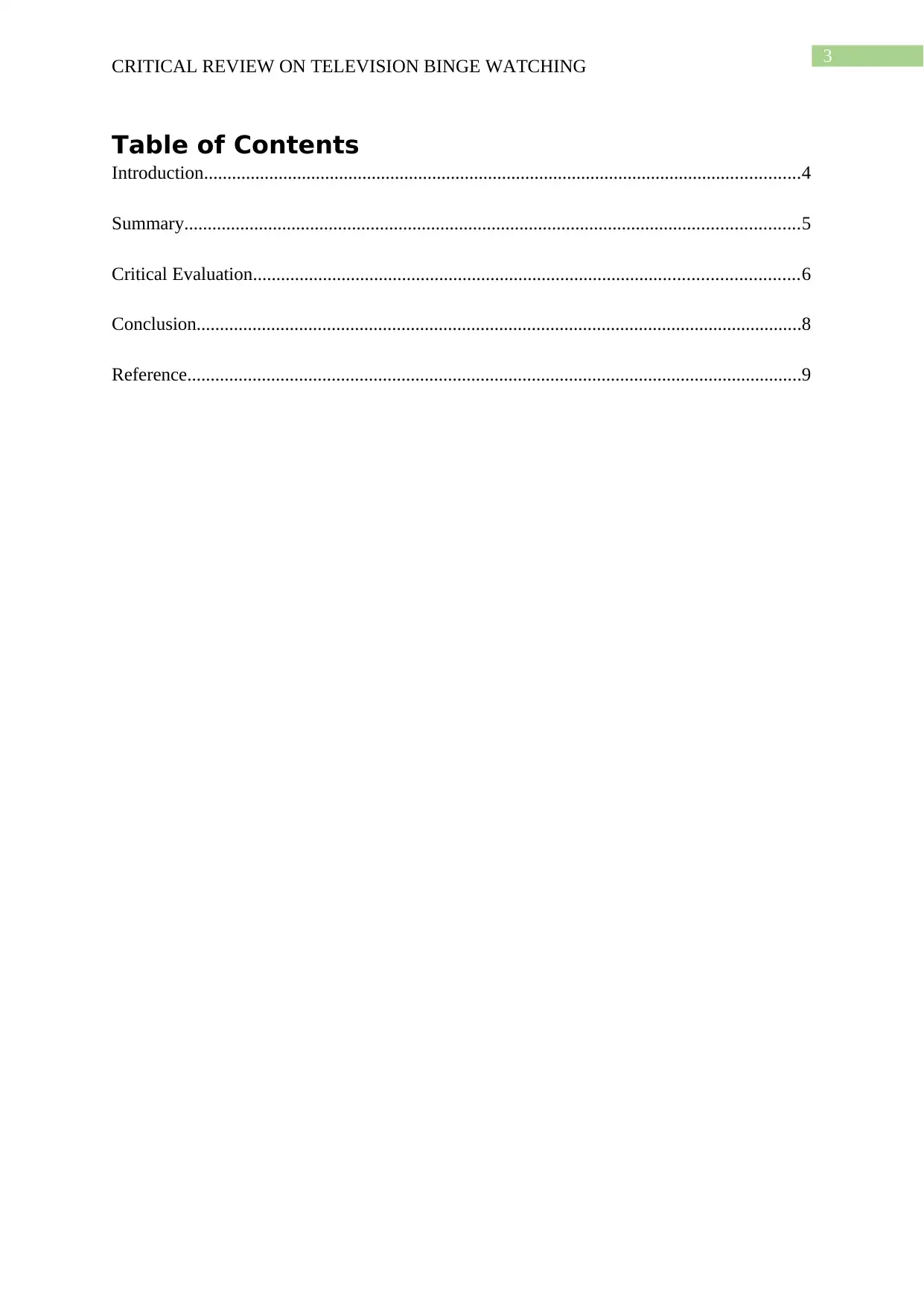
3
CRITICAL REVIEW ON TELEVISION BINGE WATCHING
Table of Contents
Introduction................................................................................................................................4
Summary....................................................................................................................................5
Critical Evaluation.....................................................................................................................6
Conclusion..................................................................................................................................8
Reference....................................................................................................................................9
CRITICAL REVIEW ON TELEVISION BINGE WATCHING
Table of Contents
Introduction................................................................................................................................4
Summary....................................................................................................................................5
Critical Evaluation.....................................................................................................................6
Conclusion..................................................................................................................................8
Reference....................................................................................................................................9
⊘ This is a preview!⊘
Do you want full access?
Subscribe today to unlock all pages.

Trusted by 1+ million students worldwide
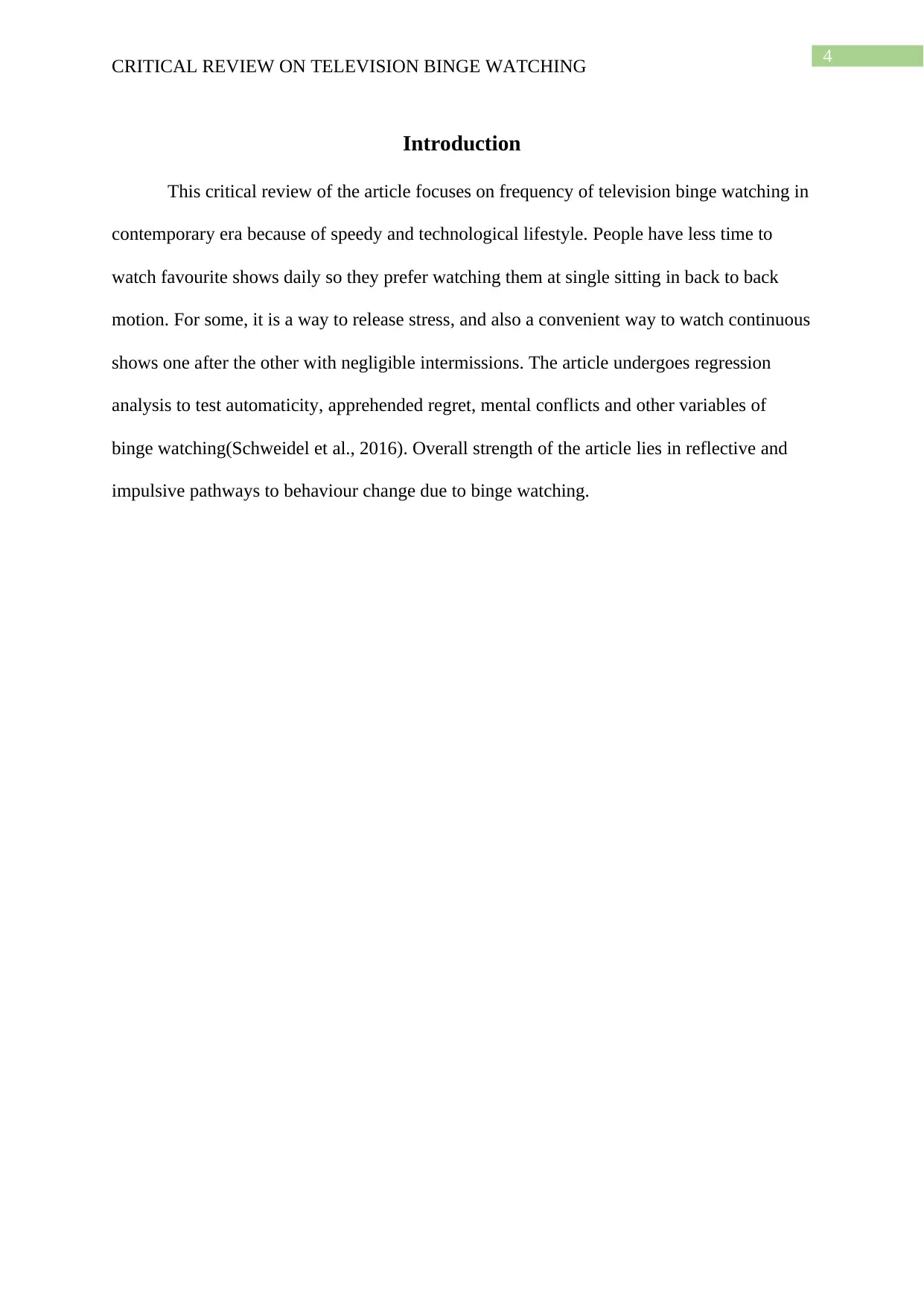
4
CRITICAL REVIEW ON TELEVISION BINGE WATCHING
Introduction
This critical review of the article focuses on frequency of television binge watching in
contemporary era because of speedy and technological lifestyle. People have less time to
watch favourite shows daily so they prefer watching them at single sitting in back to back
motion. For some, it is a way to release stress, and also a convenient way to watch continuous
shows one after the other with negligible intermissions. The article undergoes regression
analysis to test automaticity, apprehended regret, mental conflicts and other variables of
binge watching(Schweidel et al., 2016). Overall strength of the article lies in reflective and
impulsive pathways to behaviour change due to binge watching.
CRITICAL REVIEW ON TELEVISION BINGE WATCHING
Introduction
This critical review of the article focuses on frequency of television binge watching in
contemporary era because of speedy and technological lifestyle. People have less time to
watch favourite shows daily so they prefer watching them at single sitting in back to back
motion. For some, it is a way to release stress, and also a convenient way to watch continuous
shows one after the other with negligible intermissions. The article undergoes regression
analysis to test automaticity, apprehended regret, mental conflicts and other variables of
binge watching(Schweidel et al., 2016). Overall strength of the article lies in reflective and
impulsive pathways to behaviour change due to binge watching.
Paraphrase This Document
Need a fresh take? Get an instant paraphrase of this document with our AI Paraphraser
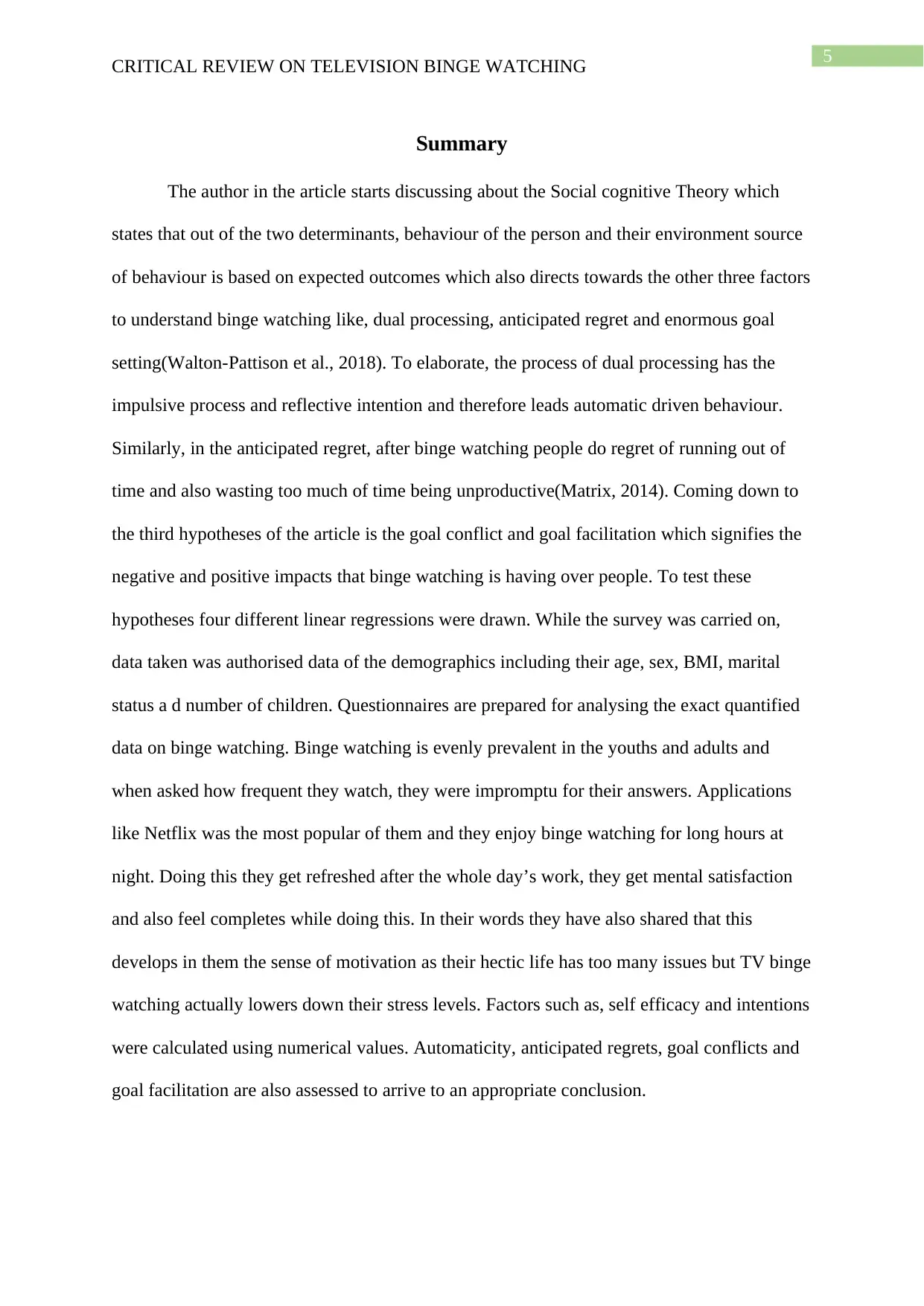
5
CRITICAL REVIEW ON TELEVISION BINGE WATCHING
Summary
The author in the article starts discussing about the Social cognitive Theory which
states that out of the two determinants, behaviour of the person and their environment source
of behaviour is based on expected outcomes which also directs towards the other three factors
to understand binge watching like, dual processing, anticipated regret and enormous goal
setting(Walton-Pattison et al., 2018). To elaborate, the process of dual processing has the
impulsive process and reflective intention and therefore leads automatic driven behaviour.
Similarly, in the anticipated regret, after binge watching people do regret of running out of
time and also wasting too much of time being unproductive(Matrix, 2014). Coming down to
the third hypotheses of the article is the goal conflict and goal facilitation which signifies the
negative and positive impacts that binge watching is having over people. To test these
hypotheses four different linear regressions were drawn. While the survey was carried on,
data taken was authorised data of the demographics including their age, sex, BMI, marital
status a d number of children. Questionnaires are prepared for analysing the exact quantified
data on binge watching. Binge watching is evenly prevalent in the youths and adults and
when asked how frequent they watch, they were impromptu for their answers. Applications
like Netflix was the most popular of them and they enjoy binge watching for long hours at
night. Doing this they get refreshed after the whole day’s work, they get mental satisfaction
and also feel completes while doing this. In their words they have also shared that this
develops in them the sense of motivation as their hectic life has too many issues but TV binge
watching actually lowers down their stress levels. Factors such as, self efficacy and intentions
were calculated using numerical values. Automaticity, anticipated regrets, goal conflicts and
goal facilitation are also assessed to arrive to an appropriate conclusion.
CRITICAL REVIEW ON TELEVISION BINGE WATCHING
Summary
The author in the article starts discussing about the Social cognitive Theory which
states that out of the two determinants, behaviour of the person and their environment source
of behaviour is based on expected outcomes which also directs towards the other three factors
to understand binge watching like, dual processing, anticipated regret and enormous goal
setting(Walton-Pattison et al., 2018). To elaborate, the process of dual processing has the
impulsive process and reflective intention and therefore leads automatic driven behaviour.
Similarly, in the anticipated regret, after binge watching people do regret of running out of
time and also wasting too much of time being unproductive(Matrix, 2014). Coming down to
the third hypotheses of the article is the goal conflict and goal facilitation which signifies the
negative and positive impacts that binge watching is having over people. To test these
hypotheses four different linear regressions were drawn. While the survey was carried on,
data taken was authorised data of the demographics including their age, sex, BMI, marital
status a d number of children. Questionnaires are prepared for analysing the exact quantified
data on binge watching. Binge watching is evenly prevalent in the youths and adults and
when asked how frequent they watch, they were impromptu for their answers. Applications
like Netflix was the most popular of them and they enjoy binge watching for long hours at
night. Doing this they get refreshed after the whole day’s work, they get mental satisfaction
and also feel completes while doing this. In their words they have also shared that this
develops in them the sense of motivation as their hectic life has too many issues but TV binge
watching actually lowers down their stress levels. Factors such as, self efficacy and intentions
were calculated using numerical values. Automaticity, anticipated regrets, goal conflicts and
goal facilitation are also assessed to arrive to an appropriate conclusion.
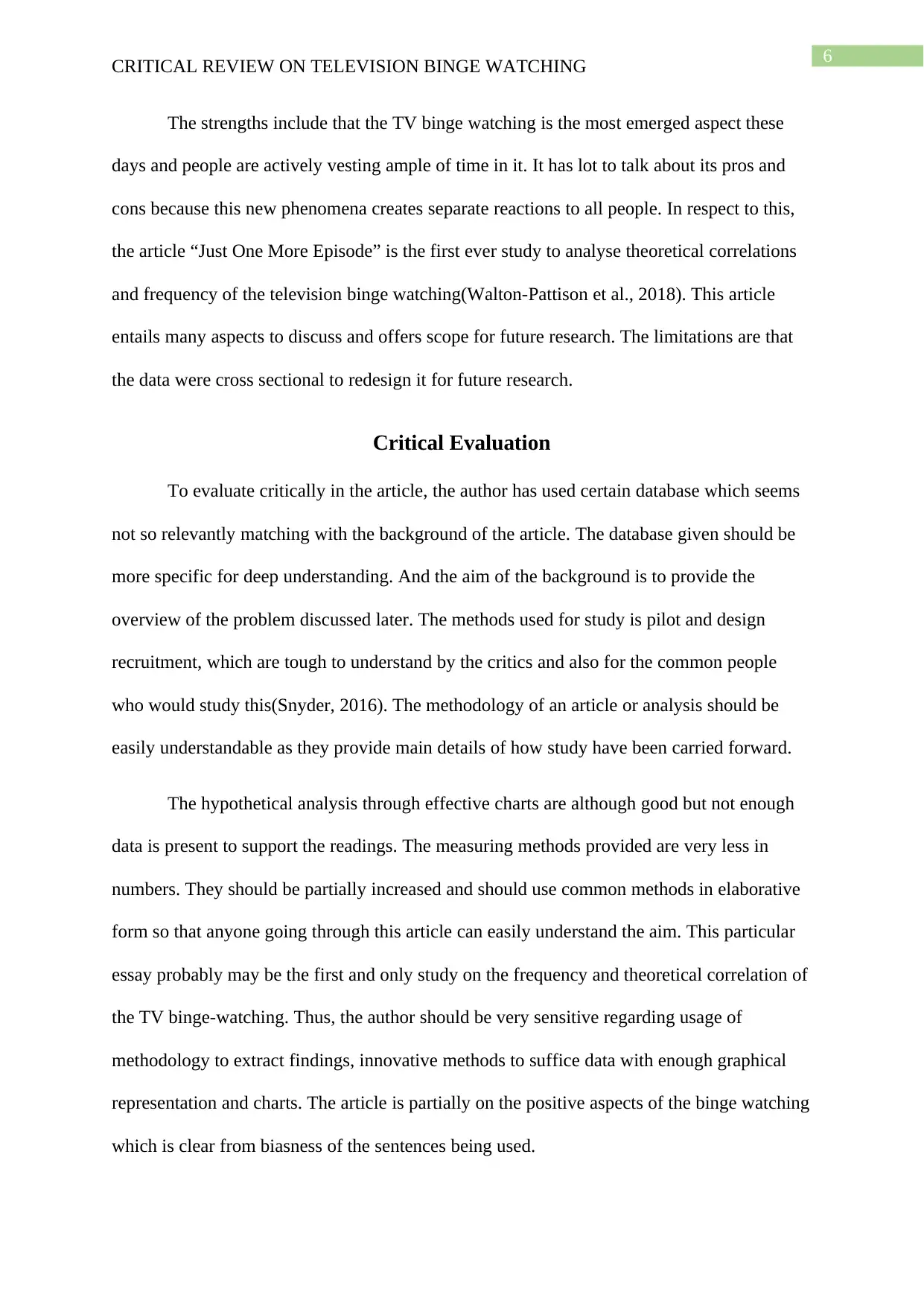
6
CRITICAL REVIEW ON TELEVISION BINGE WATCHING
The strengths include that the TV binge watching is the most emerged aspect these
days and people are actively vesting ample of time in it. It has lot to talk about its pros and
cons because this new phenomena creates separate reactions to all people. In respect to this,
the article “Just One More Episode” is the first ever study to analyse theoretical correlations
and frequency of the television binge watching(Walton-Pattison et al., 2018). This article
entails many aspects to discuss and offers scope for future research. The limitations are that
the data were cross sectional to redesign it for future research.
Critical Evaluation
To evaluate critically in the article, the author has used certain database which seems
not so relevantly matching with the background of the article. The database given should be
more specific for deep understanding. And the aim of the background is to provide the
overview of the problem discussed later. The methods used for study is pilot and design
recruitment, which are tough to understand by the critics and also for the common people
who would study this(Snyder, 2016). The methodology of an article or analysis should be
easily understandable as they provide main details of how study have been carried forward.
The hypothetical analysis through effective charts are although good but not enough
data is present to support the readings. The measuring methods provided are very less in
numbers. They should be partially increased and should use common methods in elaborative
form so that anyone going through this article can easily understand the aim. This particular
essay probably may be the first and only study on the frequency and theoretical correlation of
the TV binge-watching. Thus, the author should be very sensitive regarding usage of
methodology to extract findings, innovative methods to suffice data with enough graphical
representation and charts. The article is partially on the positive aspects of the binge watching
which is clear from biasness of the sentences being used.
CRITICAL REVIEW ON TELEVISION BINGE WATCHING
The strengths include that the TV binge watching is the most emerged aspect these
days and people are actively vesting ample of time in it. It has lot to talk about its pros and
cons because this new phenomena creates separate reactions to all people. In respect to this,
the article “Just One More Episode” is the first ever study to analyse theoretical correlations
and frequency of the television binge watching(Walton-Pattison et al., 2018). This article
entails many aspects to discuss and offers scope for future research. The limitations are that
the data were cross sectional to redesign it for future research.
Critical Evaluation
To evaluate critically in the article, the author has used certain database which seems
not so relevantly matching with the background of the article. The database given should be
more specific for deep understanding. And the aim of the background is to provide the
overview of the problem discussed later. The methods used for study is pilot and design
recruitment, which are tough to understand by the critics and also for the common people
who would study this(Snyder, 2016). The methodology of an article or analysis should be
easily understandable as they provide main details of how study have been carried forward.
The hypothetical analysis through effective charts are although good but not enough
data is present to support the readings. The measuring methods provided are very less in
numbers. They should be partially increased and should use common methods in elaborative
form so that anyone going through this article can easily understand the aim. This particular
essay probably may be the first and only study on the frequency and theoretical correlation of
the TV binge-watching. Thus, the author should be very sensitive regarding usage of
methodology to extract findings, innovative methods to suffice data with enough graphical
representation and charts. The article is partially on the positive aspects of the binge watching
which is clear from biasness of the sentences being used.
⊘ This is a preview!⊘
Do you want full access?
Subscribe today to unlock all pages.

Trusted by 1+ million students worldwide
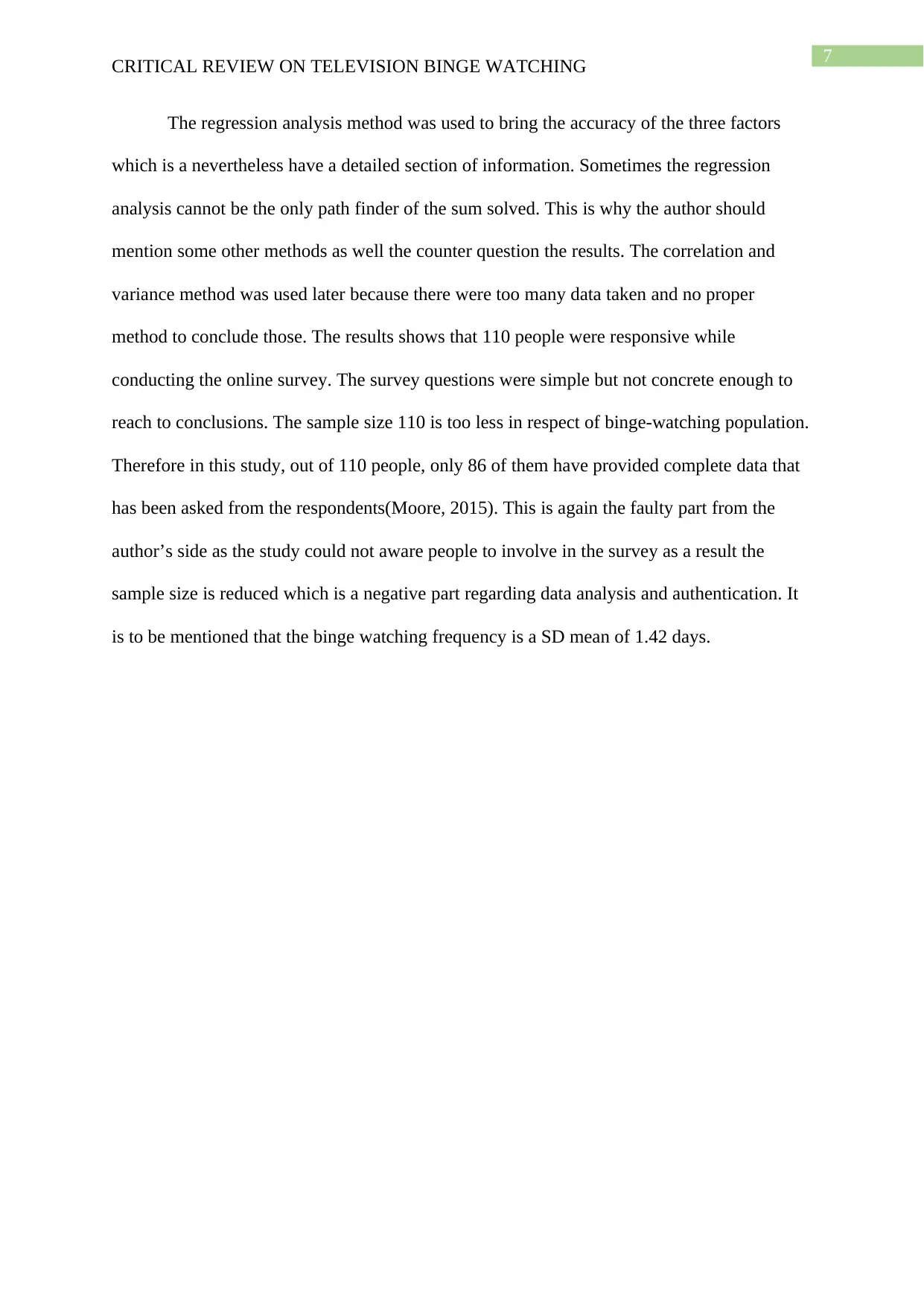
7
CRITICAL REVIEW ON TELEVISION BINGE WATCHING
The regression analysis method was used to bring the accuracy of the three factors
which is a nevertheless have a detailed section of information. Sometimes the regression
analysis cannot be the only path finder of the sum solved. This is why the author should
mention some other methods as well the counter question the results. The correlation and
variance method was used later because there were too many data taken and no proper
method to conclude those. The results shows that 110 people were responsive while
conducting the online survey. The survey questions were simple but not concrete enough to
reach to conclusions. The sample size 110 is too less in respect of binge-watching population.
Therefore in this study, out of 110 people, only 86 of them have provided complete data that
has been asked from the respondents(Moore, 2015). This is again the faulty part from the
author’s side as the study could not aware people to involve in the survey as a result the
sample size is reduced which is a negative part regarding data analysis and authentication. It
is to be mentioned that the binge watching frequency is a SD mean of 1.42 days.
CRITICAL REVIEW ON TELEVISION BINGE WATCHING
The regression analysis method was used to bring the accuracy of the three factors
which is a nevertheless have a detailed section of information. Sometimes the regression
analysis cannot be the only path finder of the sum solved. This is why the author should
mention some other methods as well the counter question the results. The correlation and
variance method was used later because there were too many data taken and no proper
method to conclude those. The results shows that 110 people were responsive while
conducting the online survey. The survey questions were simple but not concrete enough to
reach to conclusions. The sample size 110 is too less in respect of binge-watching population.
Therefore in this study, out of 110 people, only 86 of them have provided complete data that
has been asked from the respondents(Moore, 2015). This is again the faulty part from the
author’s side as the study could not aware people to involve in the survey as a result the
sample size is reduced which is a negative part regarding data analysis and authentication. It
is to be mentioned that the binge watching frequency is a SD mean of 1.42 days.
Paraphrase This Document
Need a fresh take? Get an instant paraphrase of this document with our AI Paraphraser
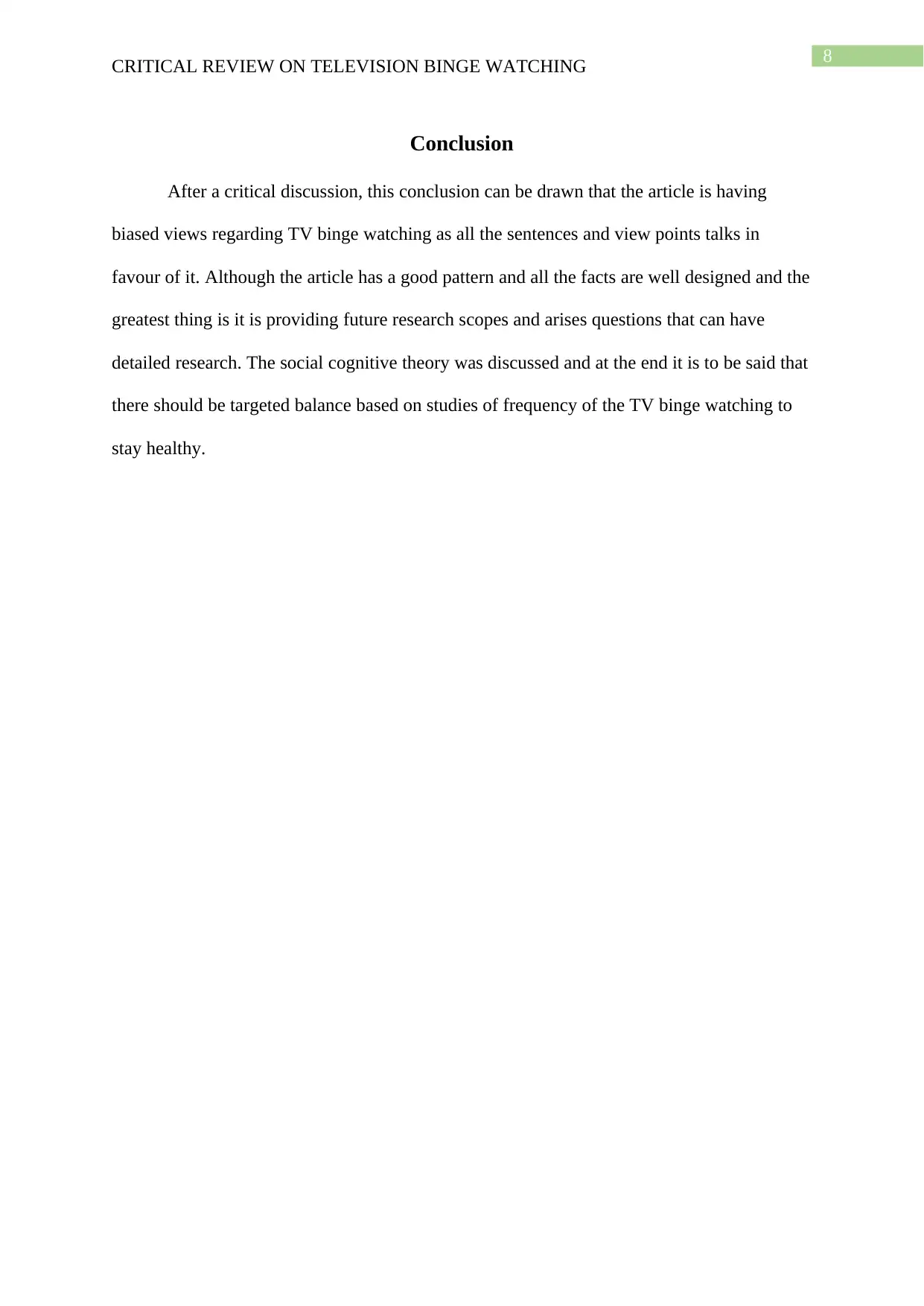
8
CRITICAL REVIEW ON TELEVISION BINGE WATCHING
Conclusion
After a critical discussion, this conclusion can be drawn that the article is having
biased views regarding TV binge watching as all the sentences and view points talks in
favour of it. Although the article has a good pattern and all the facts are well designed and the
greatest thing is it is providing future research scopes and arises questions that can have
detailed research. The social cognitive theory was discussed and at the end it is to be said that
there should be targeted balance based on studies of frequency of the TV binge watching to
stay healthy.
CRITICAL REVIEW ON TELEVISION BINGE WATCHING
Conclusion
After a critical discussion, this conclusion can be drawn that the article is having
biased views regarding TV binge watching as all the sentences and view points talks in
favour of it. Although the article has a good pattern and all the facts are well designed and the
greatest thing is it is providing future research scopes and arises questions that can have
detailed research. The social cognitive theory was discussed and at the end it is to be said that
there should be targeted balance based on studies of frequency of the TV binge watching to
stay healthy.
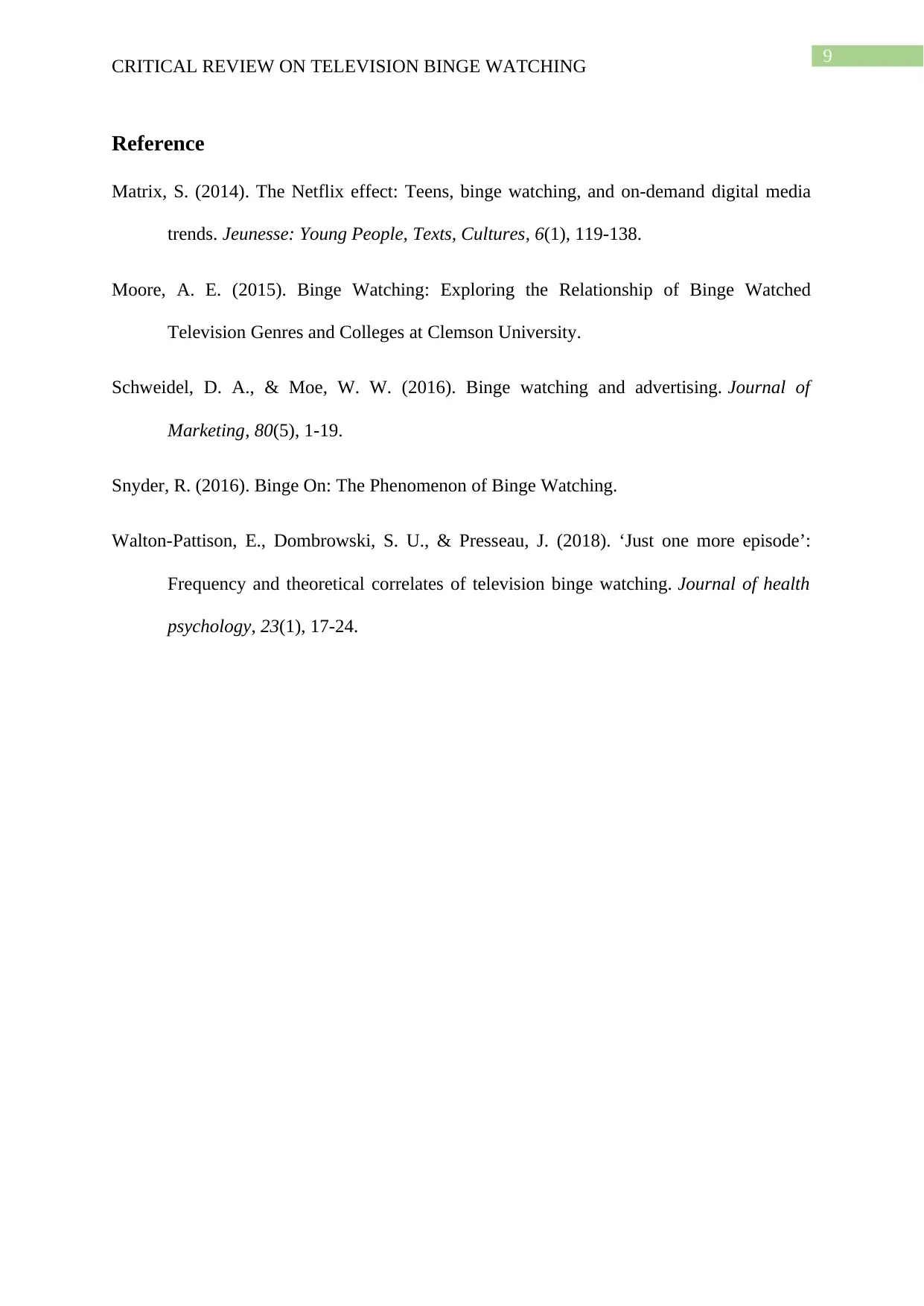
9
CRITICAL REVIEW ON TELEVISION BINGE WATCHING
Reference
Matrix, S. (2014). The Netflix effect: Teens, binge watching, and on-demand digital media
trends. Jeunesse: Young People, Texts, Cultures, 6(1), 119-138.
Moore, A. E. (2015). Binge Watching: Exploring the Relationship of Binge Watched
Television Genres and Colleges at Clemson University.
Schweidel, D. A., & Moe, W. W. (2016). Binge watching and advertising. Journal of
Marketing, 80(5), 1-19.
Snyder, R. (2016). Binge On: The Phenomenon of Binge Watching.
Walton-Pattison, E., Dombrowski, S. U., & Presseau, J. (2018). ‘Just one more episode’:
Frequency and theoretical correlates of television binge watching. Journal of health
psychology, 23(1), 17-24.
CRITICAL REVIEW ON TELEVISION BINGE WATCHING
Reference
Matrix, S. (2014). The Netflix effect: Teens, binge watching, and on-demand digital media
trends. Jeunesse: Young People, Texts, Cultures, 6(1), 119-138.
Moore, A. E. (2015). Binge Watching: Exploring the Relationship of Binge Watched
Television Genres and Colleges at Clemson University.
Schweidel, D. A., & Moe, W. W. (2016). Binge watching and advertising. Journal of
Marketing, 80(5), 1-19.
Snyder, R. (2016). Binge On: The Phenomenon of Binge Watching.
Walton-Pattison, E., Dombrowski, S. U., & Presseau, J. (2018). ‘Just one more episode’:
Frequency and theoretical correlates of television binge watching. Journal of health
psychology, 23(1), 17-24.
⊘ This is a preview!⊘
Do you want full access?
Subscribe today to unlock all pages.

Trusted by 1+ million students worldwide
1 out of 9
Your All-in-One AI-Powered Toolkit for Academic Success.
+13062052269
info@desklib.com
Available 24*7 on WhatsApp / Email
![[object Object]](/_next/static/media/star-bottom.7253800d.svg)
Unlock your academic potential
Copyright © 2020–2025 A2Z Services. All Rights Reserved. Developed and managed by ZUCOL.
